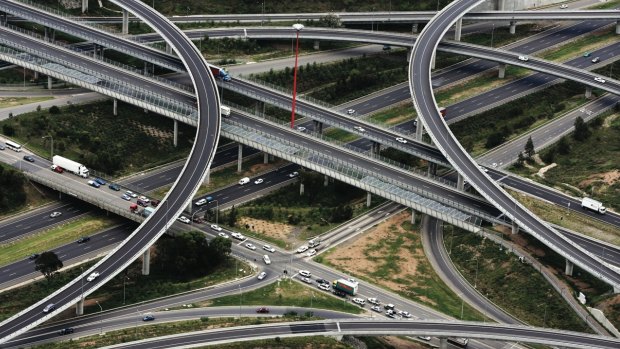By Malcolm Maiden
Here's the paradox about infrastructure: there's too much money trying to buy it and not enough money trying to build it.
A conga line of institutions have been lining up to buy Australian infrastructure. It doesn't matter that much where it is, or what it does. If it is up and running, it's worth a fortune.
An ordinary company might change hands for 10 times its annual cash flow if its shareholders are lucky. Australian super funds, overseas pension funds and sovereign funds are prepared to pay more than twice that for existing infrastructure.
They reckon it's worth it because they have long-term payout obligations, and infrastructure throws off reliable long-term income.

Both sides talking about Commonwealth debt funding for infrastructure is a big step forward.Credit: Louie Douvis
However, the same institutions are more leery about investing in new infrastructure projects.
They know that, in time, it will be old infrastructure, reliably churning out cash, but have seen investments in new toll roads and tunnels come a cropper in this country. They are wary about sinking capital into projects that have multi-year construction times and development risk that includes assumptions about cash flow that can only be tested when the infrastructure is open for business.
The way Malcolm Turnbull's Major Projects Minister, Paul Fletcher, describes it is that Australia has an infrastructure financing gap, not an infrastructure funding gap.
There is a wall of money out there for new investment if the right conditions are created, and one of the promising developments since Turnbull flipped the switch from autopilot is that both the government and the opposition are not only talking about ways to create the right conditions, but talking about the government taking on new debt, and co-investing.
Labor leader Bill Shorten announced this month that a Labor government would turn the infrastructure project scrutineer, Infrastructure Australia, into a project incubator that would have $10 billion of seed capital, including $6.4 billion that the government would borrow.
Before Turnbull became Prime Minister in mid-September, Shorten's announcement would have produced a torrent of sound bites from the government about Labor's great big, bad, spending habit, and Infrastructure Minister Warren Truss did head down that well-trodden path by calling the proposal a "thought bubble".
However, the new Treasurer, Scott Morrison, was more reflective.
Labor was talking about borrowing money to lend money to projects that were going to make money, and hadn't been very good at that in the past, he said, but investing in infrastructure was a good idea, and Shorten's plan shouldn't be dismissed out of hand.
A few days after that, Turnbull reversed an Abbott government decision by pledging $95 million for the second stage of a Gold Coast light rail project, in the process floating the idea that infrastructure financing could be made more attractive by securitising and front-loading gains in land tax revenue that flowed from higher property values in areas favourably affected by the project.
In an interview with Fairfax Media at the weekend, he also hinted a Turnbull government could borrow to invest in new infrastructure, either alone or in partnership with state governments.
The AAA-rated government was the lowest-cost borrower in the land and it could make sense for it to "have a piece" of infrastructure investment, Turnbull said.
This is partly a change in political optics.
The Abbott government was aware of the infrastructure funding-financing paradox.
Its $5 billion five-year asset-recycling initiative that pays states an additional 15 per cent of infrastructure sale proceeds that are redirected to new infrastructure spending was one response. A decision to provide an additional $2 billion of debt funding for the NSW government to allow the state to build two stages of its WestConnex tollway project and prove up revenue and profits before considering selling to the private sector was another.
However, both sides now are openly discussing the financing gap and ways to close it. They are also acknowledging that with interest rates and government bond yields still close to record lows, government debt funding is part of the solution, even as spending cuts and revenue-raising measures are considered to get the Commonwealth budget deficit back into surplus.
The government has to work with the states, and, as the Productivity Commission has pointed out, the right projects still have to be selected.
Whether Infrastructure Australia should both scope them and invest in them as Labor proposes is up for debate.
However, for mine, having both sides talk openly about Commonwealth debt funding for infrastructure is a big step forward. Maybe we can begin talking about how much debt could be raised: even $50 billion would not endanger Australia's AAA credit rating.